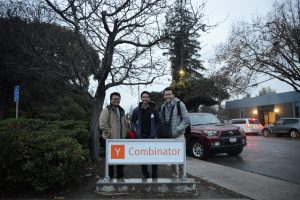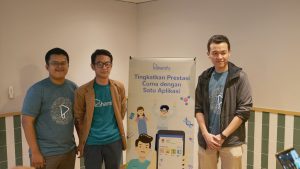There’s the famous quote of Steve Jobs from his 2005 Stanford commencement address, “You have to trust that the dots will somehow connect in your future. You have to trust in something-your gut, destiny, life, karma, whatever. This approach has never let me down, and it has made all the difference in my life.”
Being an entrepreneur, I’ve realized that these dots are all the more ambiguous and roundabout than other journeys, but at the same time, they all fall into place. We’ve recently graduated from Y Combinator’s Winter 2020 batch with $150K in funding, following the launch of our app for senior high school students last year.
This milestone coincides with education systems around the world being forced to make sudden adjustments with the coronavirus, and where the value of edtech platforms are being put to the test. As we gear up for growth in the face of the changing education landscape ahead, it’s important to take stock of these dots and the lessons I’ve picked up along the way.

Pahamify founders at YC Campus
An Education in Indonesia’s education system
I didn’t go through my education determined to be an entrepreneur. I entered the top engineering institute in Indonesia, Institut Teknologi Bandung (ITB), when I was 15 years old without the slightest entrepreneurial vision in mind. During my time in ITB, I was a student representative on the board of trustees, which gave me deeper insight into Indonesia’s education system. The experience inspired me to find ways to improve the way things were being done in my country, even as I took my postgraduate studies in Singapore.
From my research and observation, there are three major gaps in Indonesian education, and these are not necessarily infrastructural, but problems embedded within the kind of mindset and culture our education system has promoted.
First is the gap between the one-size-fits-all approach and the reality that everyone learns differently, at different paces.
Second is the misalignment between career and education. There’s a lack of institutionalized guidance when it comes to linking studies and career plans. Students don’t feel that what they are learning will be important to them later on, especially before they enter university.
Finally, students learn a lot, but don’t necessarily learn how to learn. According to the PISA test, Indonesian students are highly motivated, but it doesn’t reflect in their performance. This means that there’s a gap between what they want and how to achieve these aspirations.
In spite of these gaps, the momentum in Indonesia’s education system has been towards improvement. There’s been changes in the system everywhere, especially for the college entrance examination. This is the wave my co-founders and I rode on more than two years ago, and we are committed to accelerating this improvement in the long-term.
An Education in Learning
For my postgraduate studies I went to NTU when I was 20 years old. As I was being trained as a researcher, I also became hungry for innovation that could be applied in real life situations. Seeing the struggle of my professors getting grants made me think twice about becoming a professor myself if I wanted to make real and effective change in Indonesia.
At the same time, my studies in NTU helped me discover my passion for teaching. On the side I began a Youtube channel, inspired by the concept of flipped based learning. As the channel took off I decided to focus my efforts on teaching through Youtube, and so I decided not to complete my PhD. There was joy in communicating things in a simpler way for others. The concepts I talked about in my videos were things I had been taking for granted, but were amazing to my viewers.
Over the course of making Youtube videos, I learned about startups and realized that bringing together technology, education, and content is what I want to do and what I believe could really bring change to Indonesia. That is how Pahamify came to be.
My experience as a Youtuber was the starting point for Pahamify. With the curriculum as our mold, our team collaborates on the content, produces videos following the mold, tests it with students to get feedback and iterate. With this process, we quickly put together content early on, and continually update this library of content.
At the core of our content creation is the constructivist learning theory. It simply means that in order to make learning effective, one needs to be able to relate it to a personal experience or another idea one is already familiar with. That’s actually how our brain works, and that’s how we produce our content. We tell stories that reinforce what students already learn in the classroom by allowing them to relate concepts to things they are familiar with.
Below is one of our latest videos on the coronavirus. (No english subtitles)
And as we built an app to distribute our library of content, we’ve also leveraged gamification to add another layer of constructivist learning and make the learning experience more engaging. We turn lessons into levels where students can answer questions after viewing videos and gain points as users on the platform. These levels fall into categories according to subjects and skillsets, organized in a way that students can easily start where they left off or sync up with what they’re learning in the classroom. Another way we’ve leveraged on gamification is through avatars. Students with enough points can purchase avatars that can reflect their future aspirations, say pilot or rocket engineer.
When it comes to careers, we’ve also gone a step further and included information on colleges they can go to and in-app consultation with career advisers. This way we’ve geared our app to make the experience more personal to each student, and in doing so address the second gap I mentioned earlier.

Pahamify founders at app launch
With this app supplementing what students learn in the classroom, we want these engagements to also shape what happens in the classroom of the future. With information from the app, we want to be able to equip teachers with the information they need to be good mentors to their students and teach more effectively. That way students can talk about the videos and interactions they have on the app with their teachers.
When it comes to product development, we devised the “PAHAMI Framework” to translate key research findings in neuroscience into effective, student-centered features that improve learning retention. That way the constructivist learning, flipped classroom, and all these theories goes into creating a user experience designed for students. This experience begins with the lessons they learn in the classroom, then their interactions on the app, and finally back to the classroom through their teacher.
An Education in Entrepreneurship
It’s been more than two years since I co-founded Pahamify. Throughout the process of building Pahamify, I am very fortunate to have had what I call “lucky networks.” These “lucky networks” are people with whom I have had an authentic relationship and then they turned out to be in a position where they provided me with advice and help later on. When I became one of the Youtube Top Creators, I found out the country manager and I took the same class in college, and he was very helpful in guiding me as a startup founder. I also gained many insights for management and strategy from college friends who hold management positions in Indonesian unicorns.
As I sought to reimagine education in Indonesia, I’ve also received my own education in entrepreneurship. From making tough hiring decisions, to learning the ropes of finances, and building a culture and structure for the company, it’s many miles apart from the PhD I was once taking. But I’ve never been alone in figuring these things out, having been able to seek advice from my college friends who have been through it all. I was also lucky enough to learn the “science of start-ups” in Y Combinator as Pahamify was accepted in the Winter 2020 batch of the Silicon Valley incubator.
After hearing the stories of top startup founders, I learned that there is no one road leading to Rome. There are many ways the startup journey can go wrong, but a good startup treads on the right path where it matters. And that is what I am focusing on. As we continue to grow Pahamify, the learning continues, hopefully not just for me, but for the millions of students in Indonesia.
Pahamify participated in the National Science Festival last year (with English subtitles)